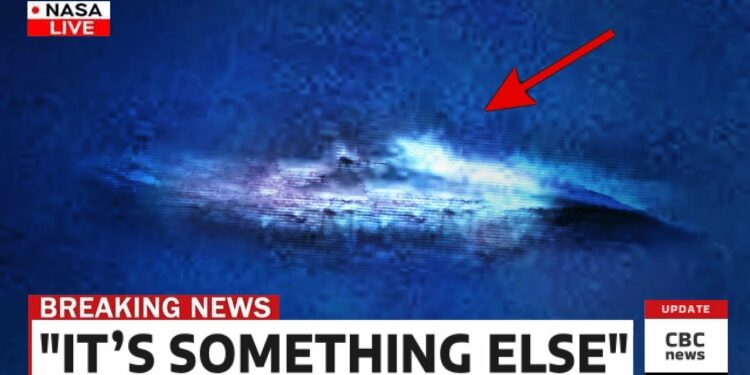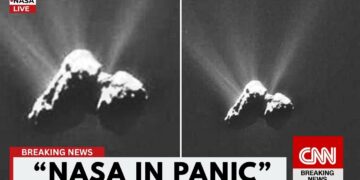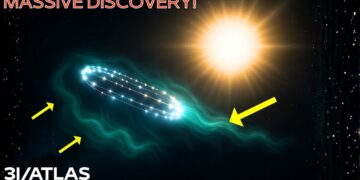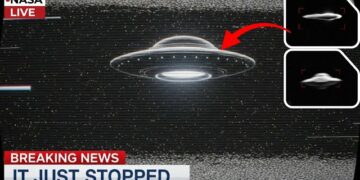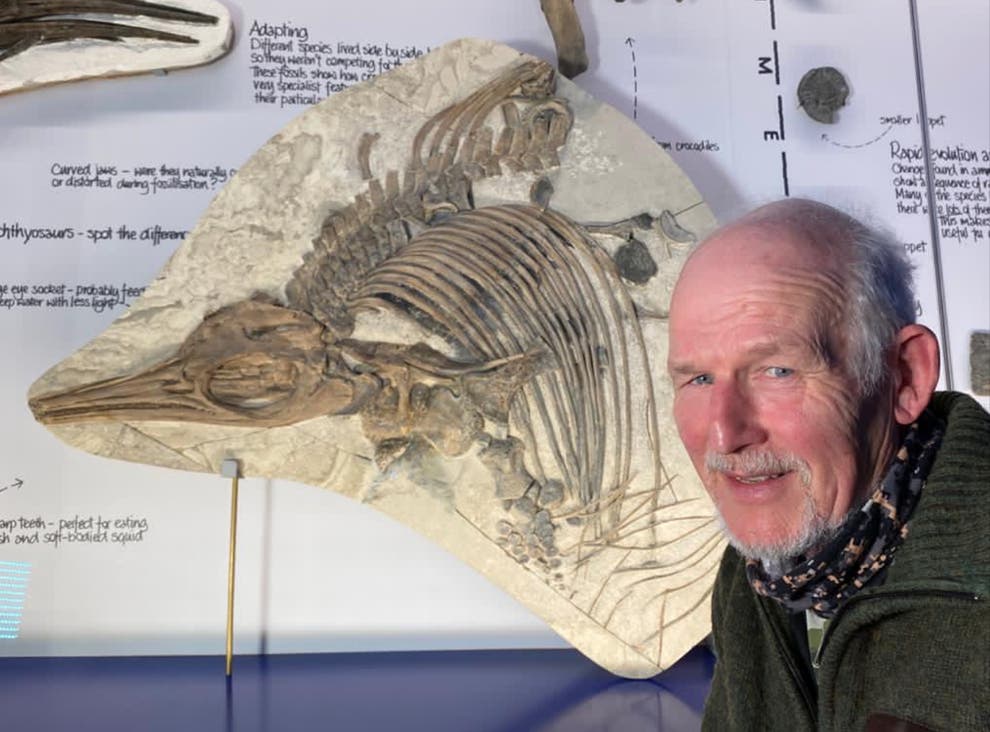A newly released image of 3I Atlas has stunned researchers worldwide, confirming it is not a comet. Once classified as a routine comet, 3I Atlas now appears to be something entirely different—something that defies simple categorization. The familiar traits of a comet are absent, replaced by anomalies that spark more questions than answers. Is this a natural fragment drifting between stars, or could it be a relic from an unknown civilization? Let’s explore.
When the Universe Got Strange
On July 1, 2025, what should have been a routine night at the Atlas survey in Chile turned extraordinary. The Atlas telescopes, designed to spot asteroids, comets, and space debris, regularly catalog moving objects that reflect sunlight. Most are assigned a designation and filed away in databases. But when computers calculated 3I Atlas’s speed at 130,000 miles per hour, slicing through our solar system with uncanny precision, the routine ended abruptly. That night, the Atlas telescopes—four robotic sentinels perched on volcanic peaks in Hawaii—made history.
These telescopes, cosmic security cameras, photograph the sky every few minutes, using software to detect movement against the starry backdrop. When 3I Atlas was flagged, it wasn’t just moving—it was racing through space faster than anything born in our solar system should. At 58 km/s relative to the sun, this object had likely traveled millions of years across interstellar space before entering our cosmic neighborhood. Unlike local objects, which require a gravitational boost from a planet like Jupiter to reach such speeds, 3I Atlas was arriving, not departing. Its hyperbolic trajectory pointed to an origin far beyond our solar system.
The statistics were staggering. Approaching within 5° of the ecliptic plane—where our planets orbit—had odds of about 2 in 1,000. Its path also aligned for sequential flybys of Mars, Venus, and Jupiter, with a combined probability of less than 1 in 20,000. In a universe where interstellar debris drifts randomly, these alignments suggested intent, not chance.
Chemical analysis from the James Webb Space Telescope revealed a carbon dioxide-to-water ratio eight times higher than expected, placing 3I Atlas four standard deviations outside the norm for any known comet. Even more striking, this carbon dioxide was concentrated precisely on the sun-facing side, exactly where an impossible plume pointed. The chemistry and physics were intertwined in ways natural processes couldn’t explain.
A Rule-Breaking Phenomenon
Every astronomy textbook states that comet tails form as solar radiation pushes dust and gas away from the sun, creating the iconic streaming patterns that define these celestial objects. This has held true for every comet observed, from ancient records to modern missions—until 3I Atlas rewrote the rules. Hubble’s late-July images revealed something baffling: instead of a tail flowing away from the sun, 3I Atlas was pushing material toward it in a focused, persistent beam that defied solar wind and radiation pressure.
Initially, Hubble’s operators suspected a telescope error. The Widefield Camera 3 had captured countless comet tails, always pointing away from the sun. But repeated images confirmed a narrow jet of material extending from the nucleus directly toward the star, maintaining its shape over days of observation. The Space Telescope Science Institute ran exhaustive diagnostics—calibration, pointing accuracy, and comparisons to past comet observations—all checked out. This wasn’t a glitch; it was an object behaving in ways that challenged fundamental physics.
Simulations failed to replicate this behavior. Models that reliably predicted comet tail dynamics for decades produced nonsense when fed 3I Atlas’s data. The only way to match the observations required a mechanism actively launching material with enough force to overcome solar radiation pressure. Dust dynamics codes, built for typical comets, generated errors, unable to account for heavy particles maintaining stable sunward trajectories. No natural process could explain this.
Forces That Shouldn’t Exist
Astrometric data from observatories like Lowell and Gemini South revealed a troubling pattern. Using techniques honed on countless asteroids and comets, astronomers calculated 3I Atlas’s hyperbolic trajectory with an eccentricity over six, confirming its interstellar origin. But as measurements accumulated, small discrepancies—residuals between predicted and observed positions—grew consistently, always biased toward the sun. By mid-August, the data showed a continuous force of approximately 4×10⁻⁷ m/s² acting on the object.
This force, though small, was significant in celestial mechanics, shifting 3I Atlas’s position by thousands of kilometers over weeks. It aligned perfectly with the sunward plume visible in optical observations, linking the mysterious tail to measurable orbital changes. Calculations ruled out natural outgassing: the required mass loss to produce this force was hundreds of times higher than the object’s brightness suggested. Even factoring in the unusual carbon dioxide chemistry, the math didn’t add up.
NASA’s Jet Propulsion Laboratory flagged 3I Atlas for non-gravitational monitoring, a protocol typically used for unpredictable comet outbursts. Internal memos cautiously referred to the effect as a “propulsive signature,” though official reports used neutral terms like “non-gravitational perturbations.” The consistency of measurements across independent observatories eliminated errors or instrumentation issues as explanations.
Evidence That Changes Everything
The James Webb Space Telescope’s spectroscopic data revealed a chemical profile that shattered expectations. With a carbon dioxide-to-water ratio of 8:1, 3I Atlas stood four standard deviations outside the norm for comets. This wasn’t just unusual—it was absent from our solar system’s chemical archive. Expecting familiar signatures like water vapor or carbon monoxide, the science team was stunned by carbon dioxide lines dominating the spectrum, overwhelming other features.
Martin Cordner’s team confirmed these findings at 3.3 astronomical units from the sun, with carbon dioxide’s 4.3-micron absorption signature dwarfing all else. Even carbon monoxide, common in distant comets, was only 1.4 times the water content. These measurements required long exposures to capture the faint glow of 3I Atlas, building signal-to-noise ratios for precise molecular analysis. The carbon dioxide was concentrated on the sunward face, aligning with the mysterious plume and suggesting active, directional processes rather than uniform sublimation.
Isotopic analysis added another layer of intrigue. Carbon-12 to carbon-13 ratios matched Earth’s composition with uncanny precision, hinting at formation around a star chemically similar to our sun. Yet, the overall composition was alien to our solar system, suggesting a planetary nursery with familiar chemistry but unique thermal processing. These measurements pushed the limits of James Webb’s capabilities, highlighting the unusual brightness of 3I Atlas’s carbon dioxide emissions.
Echoes of Technology
When NASA’s propulsion specialists examined 3I Atlas’s plume, they noticed unsettling similarities to ion drives used in interplanetary missions. These engines accelerate charged particles through electromagnetic fields, producing narrow, collimated exhaust streams that maintain integrity across vast distances. The resulting thrust is subtle but persistent, capable of altering spacecraft velocities over months. The engineers recognized the signature: a focused beam of particles with uniform velocities, pointing precisely in the intended direction.
3I Atlas’s plume mirrored these characteristics. Its narrow, sunward jet maintained integrity over weeks, with particles moving at uniform velocities, resisting solar wind disruption. Most strikingly, the direction suggested a deceleration maneuver, timed perfectly for gravitational assists, as described by the Oberth effect. This principle maximizes propulsion efficiency by firing engines at peak velocity near a massive body like a star—exactly what 3I Atlas appeared to be doing.
What’s Next?
The evidence surrounding 3I Atlas challenges our understanding of the cosmos. Is it a natural anomaly, or something more? Share your thoughts in the comments below, and don’t forget to like and subscribe for more updates on this cosmic mystery.

